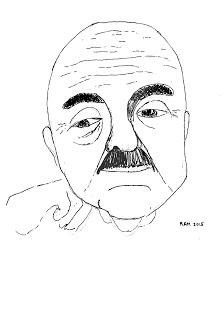 I am delighted to be able to share the following tribute to J. Louis Martyn by Prof. Joel Marcus, Professor of New Testament and Christian Origins in Duke Divinity School.
I am delighted to be able to share the following tribute to J. Louis Martyn by Prof. Joel Marcus, Professor of New Testament and Christian Origins in Duke Divinity School.--
My former doctoral advisor, J. Louis Martyn, died on June 4 at the age of 89. A long, tall Texan from Dallas, he did not initially aim at an academic career. In fact, either before or after graduating from Texas A & M in 1946 with a degree in electrical engineering, he went into his father’s plumbing and air conditioning business for a while. Somehow I found out about this early on, and at a party at which the Martyns were present, remarked to Christopher Morse, then an Assistant Professor of Systematic Theology at Union Theological Seminary in New York, how glad I was to find out that it was possible for a plumber’s son to become a theologian. (My father was a building contractor.) Christopher responded, “Yes, a sort of nuts-and-bolts theologian.” Lou was standing by, and he had in his eye the famous twinkle that I was to see many times afterwards. I am sad that I won’t see it again.
Something happened to divert Lou Martyn from plumbing (though he remained a very good plumber, carpenter, and general fixer-upper to the end of his life). For this, of course, New Testament exegetes are grateful. The diversion seems to have had something to do with a faith awakening, something to do with the electrifying experience of actually seeing someone hold a Greek New Testament in his hand and exegete it, and something to do with Dorothy Watkins, who preceded him by a year in matriculating to Andover Newton Theological School, and whom he married in 1950. He graduated from Andover Newton with a B.D. in 1953 and then went on to do a Ph.D. at Yale under Paul Schubert, writing on Heilsgechichte (a word he hated) in the Gospel of John and graduating in 1957. Moody Smith, who was his junior colleague at Yale, has remarked that Lou’s famous metaphor of the Fourth Gospel as a two-level drama was already present in the dissertation, years before he heard (probably from W. D. Davies at Union) about Birkat Ha-Minim, the rabbinic curse against heretics, which he uses in History and Theology in the Fourth Gospel to anchor the two-level analysis. And this in turn reminds me of a New Testament Colloquium at Duke, which Lou attended after he and Dorothy retired to Carolina Meadows in Chapel Hill in the late 2000s. The presenter referred to “J. Louis Martyn’s theory about John as a two-level drama,” and Lou interjected, “That’s not a theory.”
Theoretical or not, History and Theology, which Lou published in the same year that he became Edward Robinson Professor of Biblical Theology at Union (1967; he had been teaching there since 1959), changed the face of Johannine studies, cementing a turn already in progress (Barrett, Brown) towards seeing first-century Judaism as the primary religionsgeschichtlich background for the Fourth Gospel, but making this background come alive in a new way through a graphic reconstruction of the situation of the Johannine community in confrontation with the fledgling rabbinic movement. Though some aspects of this book are controversial, especially the use of Birkat Ha-Minim, it is, I think, safe to say that no postwar monograph has done more to determine the direction of subsequent Johannine studies. This is partly a tribute to Lou’s sparkling prose, to the way in which he mobilizes le mot juste and le exemple juste, and to the way in which he moves seamlessly from imaginative but factually grounded historical reconstruction to engaged theological reflection. All of these features characterize Lou’s subsequent work, which centered on Paul’s letters, especially Galatians, and climaxed in the publication of his volume on that epistle in the Anchor Bible (1997) and the essays collected in the same year as Theological Issues in the Letters of Paul. Lou used to speak of the way in which Rudolf Bultmann’s thought ran in a synchronous, mutually reinforcing pattern with John’s, even though they were separated by two millennia; it often seemed to Lou’s students and readers that the same was true of him and Paul. A former student has told me that, when she first came to Union, someone told her that the man teaching the courses on Paul actually was Paul.
As a person, Lou was unique. I have never met anyone like him. He was a great storyteller, but he also listened. I think my daughter’s sketch above captures this listening quality. He was a spellbinding lecturer, giving important words an extra push not with increased loudness but with intensified enunciation. But he was even better as a seminar leader, and even better than that in one-on-one conversation, because he always conveyed the sense that, however stupid you thought yourself to be, he was learning something from you. And I believe that he was, that he saw things in his students and, more widely, in his friends, that they didn’t see in themselves. For me, that is the definition of grace.
Joel Marcus
Duke Divinity School
